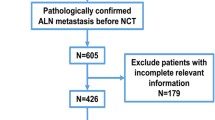Abstract
In the recent years several studies have shown that about 30% of cases with axillary node-nagative breast cancer suffer relapse of the disease. Our attempt was made to evaluate the most significant prognostic factors to predict this high risk group which may be benefited from adjuvant treatment. For this purpose, we selected 9 patients out of 80 cases of node-negative breast cancer who had been followed up at least for 5 years and had the recurrence of the disease. For comparison, 16 patients from the same group who did not have relapse were selected on a random basis. Histology, receptor status, AgNOR, DNA flow cytometry and various immunohistochemical parameters were compared between the groups with recurrence and that without recurrence.
On univariate analysis, tumor size, immunohistochemical expressions of PCNA, MIB-1, c-erbB-2 and S-phase fraction were significantly different between the above two groups. By multivariate analysis, immunohistochemicalc-erbB-2 expression (more than 50% of cancer cells) was an independent parameter.
As a summary from our studies, c-erbB-2 immunohistochemical staining on paraffin sections might be the best independent prognostic factor in axillary node-negative breast cancers.
Similar content being viewed by others
Abbreviations
- ABC:
-
Avidin biotin peroxidase complex
- AgNOR:
-
Arygrophilic nucleolar organizer
- DCC:
-
Dexrran coated charcoal
- ER:
-
Estrogen reseptot
- NOR’s:
-
Nucleolar organizer regions
- PCNA:
-
Proliferating cell unclear antigen
References
Fisher B, Redmond R, Fisher ER,et al. Relative worth of oestrogen and progesterone receptor and pathologic characteristics of differentiation as indicators of prognosis in node negative breast cancer patients; Findings from National Surgical Adjuvant Breast and Bowel Project Protocol B-06.J Clin Oncol 6:1076–1087, 1988.
Sigurdsson H, Baldetorp B, Borg A,et al: Indicators of prognosis in node negative breast cancer.N Engl J Med 322:1045–1053, 1990.
Fisher B, Redmond C, Dimitrov NV,et al: A randomized clinical trial evaluating sequential methotrexate and fluorouracil in the treatment of patients with node negative breast cancer who have estrogen receptor negative tumors.N Engl J Med 320:473–478, 1989.
Fisher B, Costantino J, Redmond C,et al: A randomized clinical trial evaluating tamoxiphen in the treatment of patients with node negative breast cancer who have estrogen-receptor positive tumors.N Engl J Med 320:479–484, 1989.
Mansour EG, Gray R, Shatila AH,et al: Efficacy of adjuvant chemotherapy in high risk node negative breast cancer.N Engl J Med 320:485–490, 1989.
Baum MB, Brinkley DM, Dosset JA,et al: Controlled trial of tamoxiphen as a single adjuvant agent in the management of early breast cancer: Analysis at eight years by Nolvadex Adjuvant Trial Organisation.Br J Cancer 57:608–611, 1988.
De Vita VT Jr: Breast cancer therapy; Exercising all our options.N Engl J Med 320:527–529, 1989.
Peters LJ, Hopwood JE, Withers HR,et al: Predictive assays of tumor radiocurability.Can Treat Sym 1:67- 74, 1984.
Wong WW, Vijayakumar S, Weichselbaum RR: Prognostic indicators in node negative early stage breast cancer.Am J Med 92:539–548, 1992.
Haybittle JL, Blarney RW, Elston CW,et al. A prognostic index in primary breast cancer.Br J Cancer 45:361–366, 1982.
McGuire WL, Tandon AK, Allred DC,et al: Prognosis and treatment decisions in patiemts with breast cancer without axillary node involvement.Cancer 70: 1775–1781, 1992.
Johnson H, Masood S, Belluco C,et al: Prognostic factors in node negative breast cancer.Arch Surg 127: 1386–1391, 1992.
Bacus SS, Ruby SG: Application of image analysis to the evaluation of cellular prognostic factors in breast carcinoma.Pathol Annu 28 (part I):179–204, 1993.
Ellias JM, Qiao L, Heimann A,et al: Paraffin embedded breast carcinomas for the immunohistochemical study of prognostic factors.J Histotechnol 15:315–320, 1992.
O’Reilly SM, Richards MA: Is DNA flow cytometry a useful investigation in breast cancer?Eur J Cancer 28:504–507, 1992.
Callahan R: p53 mutation, another cancer prognostic factor.JNCI 84:826–827, 1992.
Egan MJ, Crocker J: Nucleolar organiser regions in pathology.Br J Cancer 65:1–7, 1992.
Rochefort H: Biological and clinical significance of cathepsin D in breast cancer.Acta Oncol 31:125–130, 1992.
Perren TJ:c-erbB-2 oncogene as a prognostic marker in breast cancer.Br J Cancer 63:328–332, 1991.
Brown DC, Gatter KC: Monoclonal antibody Ki-67; Its use in histopathology.Histopathology 17:489–503, 1990.
Yu CCW, Woods AL, Levinson DA: The assessment of cellular proliferation by immunohistochemistry; A review of currently available methods and their applications.Histochem J 24:121–131, 1992.
Elston CW, Ellis IO: Pathological prognostic factors in breast cancer; 1, The value of histological grade in breast cancer; Experience from a long-term followup.Histopathology 19:403–410, 1991.
Chiu KY, Loke SL, Wong KK: Improved silver technique for showing nucleolar organizer regions in paraffin wax sections.J Clin Pathol 42:992–994, 1989.
Key G, Becker MHG, Duchrow M,et al: New Ki-67 equivalent murine monoclonal antibodies (MIB 1–3) prepared against recombinant parts of the Ki-67 antigen (Abstract 186).Ann Cell Pathol 4:181, 1992.
Hall PA, Levinson DA, Woods AL,et al: Proliferating cell nuclear antigen (PCNA) immunolocalization in paraffin sections; An index of cell proliferation with evidance of deregulated expression in some neoplasms.J Pathol 162:285–294, 1990.
Banks L, Matiashenski C, Crawford L: Isolation of human p53 specific monoclonal antibodies and their use in human p53 expression.Eur J Biochem 155:529 -534, 1986.
Gullick WJ, Borger MS, Bennett PLP,et at. Expression of the c-erbB-2 protein in normal and transformed cells.Int J Cancer 40:246–254, 1987.
Henry JA, McCarthy AL, Angus B,et al: Prognostic significance of the estrogen regulated protein, cathepsin D in breast cancer.Cancer 65:265–271, 1990.
Hedley DW, Friedlander ML, Taylor IW,et al: Method for analysis of cellular DNA content of paraffin-embedded pathological material using flow cytometry.J Histochem Cytochem 31:1333–1335, 1983.
McGuire WL: Adjuvant therapy of node negative breast cancer.N Engl J Med 320:525–527, 1989.
Kerns B-JM, Jordan PA, Huper G,et al: Assessment of c-erbB-2 amplification by immunohistochemistry in paraffin-embedded breast cancer.Modern Pathol 6: 673–678, 1993.
Isola JJ, Holli K, Oksa H,et al: Elevated erbB-2 oncoprotein levels in preoperative and follow-up serum samples define an aggressive disease course in patients with breast cancer.Cancer 73:652–658, 1994.
Author information
Authors and Affiliations
About this article
Cite this article
Khanna, A.k., Tokuda, Y., Shibuya, M. et al. Clinical and histological prognostic factors in axillary node-negative breast cancer: Univariate and multivariate analysis with relation to 5 year recurrence. Breast Cancer 2, 51–58 (1995). https://doi.org/10.1007/BF02966896
Received:
Accepted:
Issue Date:
DOI: https://doi.org/10.1007/BF02966896




